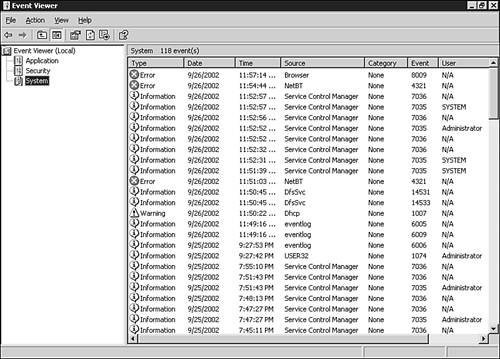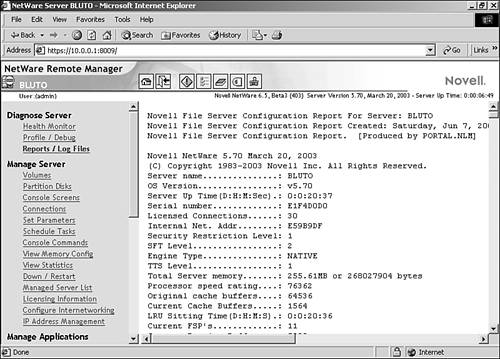Identifying Network Operating System Problems
Identifying Network Operating System ProblemsAll network operating systems provide some sort of utility (or utilities) that you can use to troubleshoot problems related to the network operating system software. These utilities allow you to perform tasks such as seeing whether software drivers for hardware devices such as NICs have loaded correctly (as the system boots up) and whether a particular application has failed. In the Microsoft Windows Server 2003 environment, a utility called the Event Viewer is provided. The Event Viewer allows you to view three different types of log files: the System Log, the Application Log, and the Security Log (we discuss the Security Log in more detail in the next chapter). As far as operating system problems go, the log you would want to take a look at is the System Log. The System Log shows information such as driver failures and failed server services. Any events related to server services and system resources will show up in this log. Figure 19.1 shows the Event Viewer's System Log. Note that errors, warnings, and other information are recorded in the Event Viewer's System Log. Figure 19.1. The Windows 2000 Server Event Viewer allows you to view software-related alerts on your server. Details on a particular event can be viewed by double-clicking that event in the Event Viewer Window. Windows Server 2003 also supplies other log files, including the Application and the Security logs. The Application log records events related to applications running on the system. The Security log records events related to audit policies that you have configured on a server such as the auditing of unsuccessful logons or access to a particular file on a file server. NetWare 6.5 also provides access to different log files that record errors and server status information automatically. For example, the SYS$LOG.ERR file lists server errors and general status information related to the server. Another server log file available in the NetWare environment is the Server Health Log File, health.log. You can view these various log files using the NetWare Remote Manager. Under the Diagnose Server category in the Remote Manager, a Reports /Log Files category is provided. Figure 19.2 shows the Remote Manager and the System Error log file. Figure 19.2. The NetWare Remote Manager makes it easier to access server log files. The NetWare Remote Manager also allows you to create configuration, security, and inventory reports for a NetWare server. These reports can be viewed in the Remote Manager window or they can sent to a particular email account and viewed. Figure 19.3 shows a server configuration report that was generated in the Remote Manager (for more about the NetWare Remote Manager, see Chapter 8, "Networking with Novell NetWare 6.5"). Figure 19.3. Server reports can be generated in the NetWare Remote Manager. Note
|
EAN: 2147483647
Pages: 188



